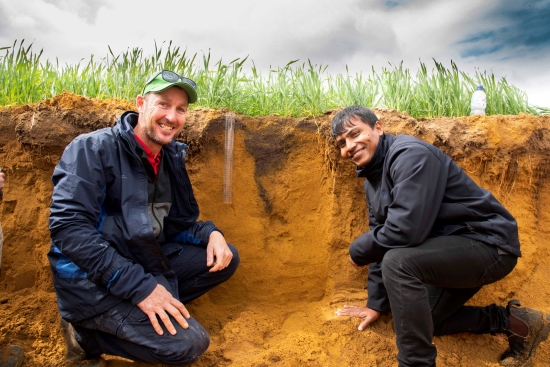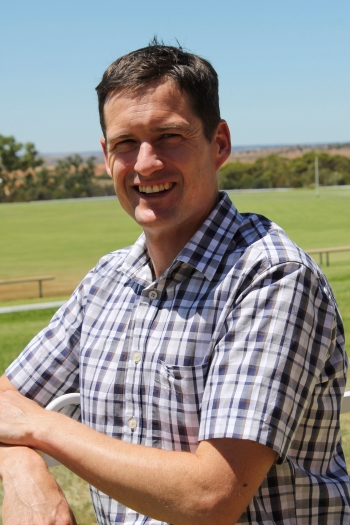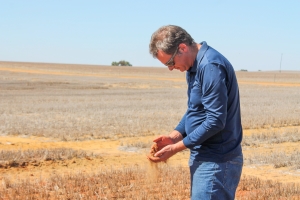Paddock Practices: Whole package approach to soil constraints advised for Western Australia
Date: 31 Jul 2019

Key points
- Yield gains, as well as the removal and prevention of soil constraints, should be the joint goal of amelioration efforts
- Strategic deep tillage coupled with soil amendment application can help overcome multiple constraints
- Decision making tools can help growers choose soil amelioration priorities for their operation.
Significant research into western region soils has identified new best practice approaches to remedying an array of soil constraints.
Methods such as applying gypsum can address soil sodicity issues, while early results from combining and incorporating some gypsum with lime on an acidic sandplain site at Kalannie has the potential to increase grain yield by up to 30 per cent.
Department of Primary Industries and Regional Development (DPIRD) research officer Dr Gaus Azam says these results warrant ongoing research to identify the mechanisms involved.
In another set of trials, which were run by DPIRD senior research scientist David Hall, gypsum was shown to improve sodic soils which have an exchangeable sodium percentage of 10 or above and improve the structure of the soil.
These findings are among those confirmed by a suite of research conducted as a part of a $33 million GRDC and DPIRD investment addressing western soil constraints. The research specifically targeted the four main soil constraints affecting WA growers in soil acidity, soil sodicity, compaction and water repellence.
Project manager and DPIRD soil science and crop nutrition portfolio manager Chris Gazey and research officer Stephen Davies detail the range of outcomes from the investment in a GRDC podcast.
In it, they highlight that these methods should be viewed as a whole-package approach, given many growers face multiple soil constraints.
Do you understand your soil constraints
Some of the many and varied options proven useful for growers to consider when addressing their soil constraints have included a focus on inversion tillage, deep ripping, lime incorporation, gypsum application, water harvesting, improved mapping of soil constraints and the development of decision tools.
Mr Gazey believes outcomes from this range of projects will better equip WA growers to understand how and why their soils are restricting plant growth. Among the resources developed to assist growers in decision-making for their soil constraints is the MySoil diagnostic tool, which classifies 15 broad soil types in WA and provides information distinguishing features of each soil type.

Compaction
Economists estimate compacted soils are costing WA growers up to $54 per hectare in lost yield potential annually.
DPIRD research officer Wayne Parker says analysis of hundreds of paddocks across WA has shown all soil types suffer compaction, with sandy soils the most affected.
Mr Parker details options for growers to address their compaction issues and how compaction is limiting their crop yield potential in a GRDC podcast.
He says research investigating the value of deep ripping with and without top soil inclusion showed almost all soils responded and often for several years. Latham grower Dylan Hirsch’s deep ripping program is one example of success with this technique and his journey is summarised in a GRDC video.
Water repellency
About 10 million hectares – just over half of WA’s wheatbelt soils – are expected to display some level of water repellency, with the popularity of dry seeding and minimum tillage farming practices exacerbating the issue.
Dr Davies says paired row or near row sowing on sandy soils has consistently resulted in a 50 per cent improvement in crop establishment, translating into 20 per cent increases in yield.
He also suggests banded wetters as a way to increase yield in forest gravel soils, with trials showing potential for up to 15 per cent yield increases. However, this method has little consistent success on deep sandy soils.
More information on this method and other tested techniques from the Soil Constraints West project are detailed in a GRDC podcast with Dr Davies.
Corrigin grower Simon Wallwork tested soil inversion with a mouldboard plough as a form of soil amelioration and was able to improve water penetration and yields on his own property.
Grower’s approach to overcoming non-wetting soils
A review of ten years’ worth of research data showed that average cereal grain yield responses in the first few years after soil inversion ranged from 30-60 per cent and 20-30 per cent higher yields were sustained over the longer-term.
Acidity
In Dr Azam’s work to understand soil acidity, lime applications were tested with and without incorporation to discover its link to aluminium toxicity and the effect on plant root growth. This also included the use of gypsum and lime together to address a common belief that the addition of gypsum will move lime through the soil profile faster.
Figure 1: Wheat yield differences on various amelioration treatments at a trial site at Kalannie. Source: DPIRD
Results show the best responses to lime come from deep incorporation at 250 millimetres or deeper as seen in figure 1. A combination of removing compaction (incorporation only) and lime to depth gave the best results. In other work, the combination of lime and gypsum increased yield by up to 30 per cent.
However, Dr Azam says gypsum can only be used on suitable soils as it does not directly increase soil pH and can slightly acidify some sandy soils if applied at a higher rate. He says this is an area for ongoing investigation to allow more accurate advice to be provided to growers. Project funding for research into soil acidity will continue until 2021.
Sodicity
Mr Hall says declining soil structure and the development of salinity in WA soils are felt largely in heavy clay soils of low-rainfall regions, but can also be a problem in higher rainfall areas.
Gypsum is recommended for growers with sodic soils which have an exchangeable sodium percentage of 10 or above in the top 30 centimetres of soil. Yield benefits were also gained from mulching and manure injection, but Mr Hall says there needs to be more efficient application strategies developed before this can be a cost-effective option.
Mr Hall says yield responses of between 30 and 90 per cent were achieved in the trials looking at the creation of mounds and furrows for water harvesting purposes. DPIRD research officer Dana Mulvany worked closely in this area over the past five years and discussed the details of this approach in a GRDC podcast.

Ongoing research
While the Soils Constraints West Project has ended, a new $48 million co-investment by both GRDC and DPIRD is set to continue work in this area.
The new research will have three areas of focus. These include:
- The yield potential of WA soils where all constraints have been removed;
- Preserving this potential using agronomic tools, such as controlled-traffic farming and crop rotations; and
- Water harvesting strategies in heavy soils, particularly those in the eastern wheatbelt
Other useful resources
DPIRD – Managing soils
GRDC Video – Do you understand your soil constraints
GRDC Video – Maximising yield potential by minimising soils constraints
GRDC Video – A grower’s approach to overcoming non-wetting soils
GRDC Video – Successful crop establishment after deep ripping
GRDC Video – Using Pre-emergents and other challenges after soil amelioration
GRDC Podcast – Soil constraints in Western Australia
GRDC Podcast – Soil amelioration – WA
GRDC Podcast – Crop Establishment – WA
GRDC Podcast – Soil Compaction
GRDC Podcast – Tips and tools to manage water repellent soils
GRDC Podcast – Sodic soils – Soil constraints west
GRDC Podcast – Pre-emergent challenges after soil amelioration
GRDC Podcast – Tips and tools to manage subsoil constraints
GRDC Podcast – Soil amelioration: A Grower case study
GRDC Project Code: DAW1401-001RTX, DAW1504-003RTX, DAW1407-002RTX, DAW1407-004RTX, DAW1407-001RTX, DAW1901-006RTX, DAW1902-001RTX, DAW1902-003RTX, DAW1901-006RTX,
Was this page helpful?
YOUR FEEDBACK
